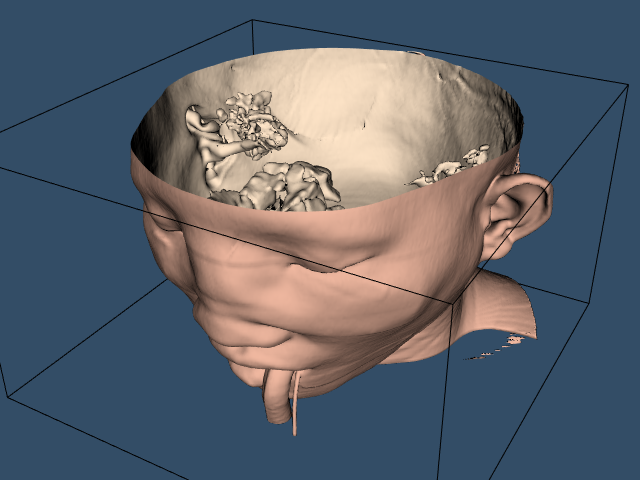MedicalDemo1
Repository source: MedicalDemo1
Description¶
The skin extracted from a CT dataset of the head.
usage
MedicalDemo1 FullHead.mhd
Note
The skin color was selected from Table 7 in Improvement of Haar Feature Based Face Detection in OpenCV Incorporating Human Skin Color Characteristic
Note
This original source code for this example is here.
Info
See Figure 12-2 in Chapter 12 the VTK Textbook.
Info
The example uses src/Testing/Data/FullHead.mhd which references src/Testing/Data/FullHead.raw.gz.
Other languages
See (Cxx), (PythonicAPI), (Java)
Question
If you have a question about this example, please use the VTK Discourse Forum
Code¶
MedicalDemo1.py
#!/usr/bin/env python
# noinspection PyUnresolvedReferences
import vtkmodules.vtkInteractionStyle
# noinspection PyUnresolvedReferences
import vtkmodules.vtkRenderingOpenGL2
from vtkmodules.vtkCommonColor import vtkNamedColors
from vtkmodules.vtkCommonCore import (
VTK_VERSION_NUMBER,
vtkVersion
)
from vtkmodules.vtkFiltersCore import (
vtkFlyingEdges3D,
vtkMarchingCubes
)
from vtkmodules.vtkFiltersModeling import vtkOutlineFilter
from vtkmodules.vtkIOImage import vtkMetaImageReader
from vtkmodules.vtkRenderingCore import (
vtkActor,
vtkCamera,
vtkPolyDataMapper,
vtkProperty,
vtkRenderWindow,
vtkRenderWindowInteractor,
vtkRenderer
)
def main():
# vtkFlyingEdges3D was introduced in VTK >= 8.2
use_flying_edges = vtk_version_ok(8, 2, 0)
colors = vtkNamedColors()
file_name = get_program_parameters()
colors.SetColor('SkinColor', [240, 184, 160, 255])
colors.SetColor('BackfaceColor', [255, 229, 200, 255])
colors.SetColor('BkgColor', [51, 77, 102, 255])
# Create the renderer, the render window, and the interactor. The renderer
# draws into the render window, the interactor enables mouse- and
# keyboard-based interaction with the data within the render window.
#
a_renderer = vtkRenderer()
ren_win = vtkRenderWindow()
ren_win.AddRenderer(a_renderer)
iren = vtkRenderWindowInteractor()
iren.SetRenderWindow(ren_win)
reader = vtkMetaImageReader()
reader.SetFileName(file_name)
# An isosurface, or contour value of 500 is known to correspond to the
# skin of the patient.
if use_flying_edges:
try:
skin_extractor = vtkFlyingEdges3D()
except AttributeError:
skin_extractor = vtkMarchingCubes()
else:
skin_extractor = vtkMarchingCubes()
skin_extractor.SetInputConnection(reader.GetOutputPort())
skin_extractor.SetValue(0, 500)
skin_mapper = vtkPolyDataMapper()
skin_mapper.SetInputConnection(skin_extractor.GetOutputPort())
skin_mapper.ScalarVisibilityOff()
skin = vtkActor()
skin.SetMapper(skin_mapper)
skin.GetProperty().SetDiffuseColor(colors.GetColor3d('SkinColor'))
back_prop = vtkProperty()
back_prop.SetDiffuseColor(colors.GetColor3d('BackfaceColor'))
skin.SetBackfaceProperty(back_prop)
# An outline provides context around the data.
#
outline_data = vtkOutlineFilter()
outline_data.SetInputConnection(reader.GetOutputPort())
map_outline = vtkPolyDataMapper()
map_outline.SetInputConnection(outline_data.GetOutputPort())
outline = vtkActor()
outline.SetMapper(map_outline)
outline.GetProperty().SetColor(colors.GetColor3d('Black'))
# It is convenient to create an initial view of the data. The FocalPoint
# and Position form a vector direction. Later on (ResetCamera() method)
# this vector is used to position the camera to look at the data in
# this direction.
a_camera = vtkCamera()
a_camera.SetViewUp(0, 0, -1)
a_camera.SetPosition(0, -1, 0)
a_camera.SetFocalPoint(0, 0, 0)
a_camera.ComputeViewPlaneNormal()
a_camera.Azimuth(30.0)
a_camera.Elevation(30.0)
# Actors are added to the renderer. An initial camera view is created.
# The Dolly() method moves the camera towards the FocalPoint,
# thereby enlarging the image.
a_renderer.AddActor(outline)
a_renderer.AddActor(skin)
a_renderer.SetActiveCamera(a_camera)
a_renderer.ResetCamera()
a_camera.Dolly(1.5)
# Set a background color for the renderer and set the size of the
# render window (expressed in pixels).
a_renderer.SetBackground(colors.GetColor3d('BkgColor'))
ren_win.SetSize(640, 480)
ren_win.SetWindowName('MedicalDemo1')
# Note that when camera movement occurs (as it does in the Dolly()
# method), the clipping planes often need adjusting. Clipping planes
# consist of two planes: near and far along the view direction. The
# near plane clips out objects in front of the plane the far plane
# clips out objects behind the plane. This way only what is drawn
# between the planes is actually rendered.
a_renderer.ResetCameraClippingRange()
# Initialize the event loop and then start it.
iren.Initialize()
iren.Start()
def get_program_parameters():
import argparse
description = 'The skin extracted from a CT dataset of the head.'
epilogue = '''
Derived from VTK/Examples/Cxx/Medical1.cxx
This example reads a volume dataset, extracts an isosurface that
represents the skin and displays it.
'''
parser = argparse.ArgumentParser(description=description, epilog=epilogue,
formatter_class=argparse.RawDescriptionHelpFormatter)
parser.add_argument('filename', help='FullHead.mhd.')
args = parser.parse_args()
return args.filename
def vtk_version_ok(major, minor, build):
"""
Check the VTK version.
:param major: Major version.
:param minor: Minor version.
:param build: Build version.
:return: True if the requested VTK version is greater or equal to the actual VTK version.
"""
needed_version = 10000000000 * int(major) + 100000000 * int(minor) + int(build)
try:
vtk_version_number = VTK_VERSION_NUMBER
except AttributeError: # as error:
ver = vtkVersion()
vtk_version_number = 10000000000 * ver.GetVTKMajorVersion() + 100000000 * ver.GetVTKMinorVersion() \
+ ver.GetVTKBuildVersion()
if vtk_version_number >= needed_version:
return True
else:
return False
if __name__ == '__main__':
main()
